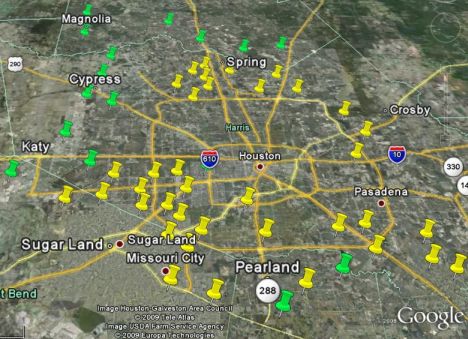Different house in U.S.
Same county
Different county
Same state
Different state
BLACK HOUSTON'S GROWTH & MIGRATION
As sprawl led to increased traffic problems much of the area inside the 610 loop became desirable once again due to its location. It has become home to many young urban professionals as well as the wealthy. All of which have priced out the middle class and working class who are continuing to migrate outside of the loop and even the Beltway.
Today the population continues to grow and shift to the areas outside of the Beltway. These areas have seen the largest increase in overall growth. Much of it is still unincorporated or belongs to one of the suburban cities. The majority of the African American population lives outside of the loop but within the Beltway. Current patterns of growth show the largest number of African Americans are choosing the Northeast area north of the Beltway and the South/Southwest areas which include both sides of the beltway.
The largest increase of African American growth, percentage-wise is in the Northern suburbs with some areas receiving growth in the triple digits. These areas still have Black populations that are well below 10% of the overall population.
20.2%
15.4%
4.9%
3.2%
1.6%
15.9%
11.0%
4.8%
3.2%
1.6%
Lived in 
 Black All Houston
Black All Houston
Population Mobility (in the past year)
African Americans in Houston are in search of new places to live at higher rates than the metropolitan area as a whole. Twenty three percent of African Americans in Houston moved from 2006 to 2007. Seventy one percent came from a different county, meaning they either relocated from outside the Houston area or left Harris County for the surrounding Fort Bend, Brazoria and Montgomery counties.

KEY ZIP CODE LEGEND
YELLOW: More than 10%increase in Black population since 2000, Blacks are more than 17% (median) of the total population, Income $35K and over (median)




GREEN: More than 100% Increase in Black population since 2000 but less than 17% Black, Income $35K and over (median)


Houston has experienced success maintaining a viable urban core largely due to its ability to diversify its economy from relying solely on energy. Another major factor is its ability to annex its surrounding suburbs keeping its tax base wealthy and slowing middle class flight which prevented the rapid decay of the cities core.
The Houston area geography is often characterized and referenced according to its freeways. The I-610 loop is its "inner loop" and the Beltway can be described as its "outer loop". Most of pre WWII Houston existed within what is now the 610 loop. Suburbs began to spring up outside the loop and after the civil rights era much of the area inside the loop was being abandoned by both Black and White working and middle class residents looking to move further out. These sprawling moving patterns prompted the construction of the Beltway.
 | ||||||

MENU
BLACK HOUSTON
MORE HOUSTON
THE SUBURBS
